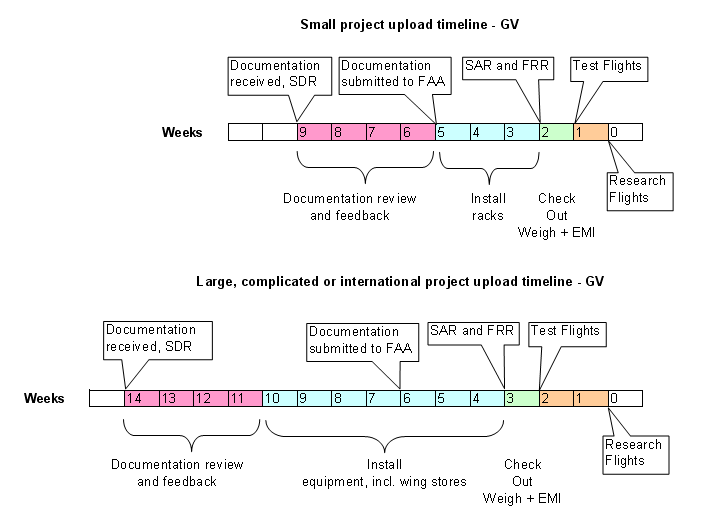Aircraft Upload Timeline
These charts outline the sequence of events, with approximate timing, that have to take place before and during a project upload.
The chart below outlines the approximate duration of a typical aircraft project upload. The duration of the upload and the time allotted to flight testing depends on the complexity of the payload and the location of the project. For example, for complicated payloads and projects that will be deployed to remote locations, very thorough testing is necessary and test flight period is increased to up to two weeks. For less complicated payloads and projects based out of RMMA, one week flight testing is usually sufficient.

In preparation for project upload, several reviews will take place. They are: System Definition Review (SDR), System Acceptance Review (SAR) and Flight Readiness Review (FRR).
The SDR is to be held about a month prior to the beginning of project upload. The purpose of the SDR is to assess the status of documentation and instrument readiness for project installation with sufficient time to correct omissions and mistakes in documentations. (For equipment flown previously on the GV the documentation is needed only if the equipment has since changed). Participants in the SDR are RAF staff in consultation with the lead PIs.
The next two milestones will take place one week before the first planned test flight. At this point the installations of equipment into the aircraft should be completed.
The purpose of the SAR is to assess the state of measurements from each instrument as installed on the aircraft. Instrument PIs will be asked to comment on measurements, data logging, communication with other systems, etc. and essentially provide an overview of the measurement quality at the time of the SAR. Participants in the SAR include RAF staff, instrument PIs, and the lead experiment PI.
The FRR will determine the airworthiness of the payload and will also be held one week prior to the first flight. The lead RAF aeronautical engineer will go through instrument installation one-by-one, and ask the RAF group heads (maintenance, technicians and pilots) if all required information (structural, materials, electrical, etc.) have been provided by the instrument PI. Instrument PIs do not participate in the FRR.
These reviews are not "pass-fail" exams but rather they are a formalized way of assessing the project preparedness status at several critical stages in the lead up to the project launch. We stress that the installations should essentially be done prior to the SAR and the FRR, and that the week between these reviews and the first test flight should only be used for minor instrument tune-ups, calibrations, etc.
Results of all reviews will be summarized and distributed to the project participants via E-mail.
In addition, three activities need to take place before the first test flight: the airplane must be weighed; electromagnetic interference (EMI) test conducted and all persons flying on the aircraft must attend a safety briefing. Attending an RAF safety briefing for an earlier project does not count: safety briefings are mandatory before each project.